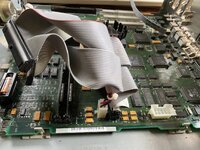Hi Everyone,
Like many of you, I'm trying to bring life back to a Quadra 650. It was working fine the last time I booted it up, around 5 years ago, and unfortunately no signs of life when I brought out of storage a few weeks ago and plugged it back in.
I took it apart and blew out the dust, replaced the PRAM battery (no damage from previous one), everything looks in good condition. Shorting pins 9 and 10 on the PSU powered up the fan. Voltage levels on all the PSU pins look OK-ish (slightly off 5v/12v etc).
With the hard disk, floppy, CD unplugged and case open, when I hit the "on button" on the keyboard, I can hear a little "tap-tap-tap-tap" from the PSU, suggesting its a problem with the trickle voltage and the soft-power on.
Does any one know an an easy way to over-ride the keyboard based mechanism (even temporarily), so that I can see if the system can boot up (to test the hard disk etc.) ?
(Or any other suggestions)
I couldn't see an easy way to safely short pins 9 and 10 when putting back the PSU (worried that one end of the "short" wire might pop out). I looked briefly at taking apart of the PSU, but a bit worried I couldn't put it back together ! (Would be great if I could find a 10 pin molex extension capable!)
(Unfortunately, a question unanswered in https://68kmla.org/bb/index.php?threads/quadra-650-dead-but-psu-works.39020/)
Many thanks,
Paul
Like many of you, I'm trying to bring life back to a Quadra 650. It was working fine the last time I booted it up, around 5 years ago, and unfortunately no signs of life when I brought out of storage a few weeks ago and plugged it back in.
I took it apart and blew out the dust, replaced the PRAM battery (no damage from previous one), everything looks in good condition. Shorting pins 9 and 10 on the PSU powered up the fan. Voltage levels on all the PSU pins look OK-ish (slightly off 5v/12v etc).
With the hard disk, floppy, CD unplugged and case open, when I hit the "on button" on the keyboard, I can hear a little "tap-tap-tap-tap" from the PSU, suggesting its a problem with the trickle voltage and the soft-power on.
Does any one know an an easy way to over-ride the keyboard based mechanism (even temporarily), so that I can see if the system can boot up (to test the hard disk etc.) ?
(Or any other suggestions)
I couldn't see an easy way to safely short pins 9 and 10 when putting back the PSU (worried that one end of the "short" wire might pop out). I looked briefly at taking apart of the PSU, but a bit worried I couldn't put it back together ! (Would be great if I could find a 10 pin molex extension capable!)
(Unfortunately, a question unanswered in https://68kmla.org/bb/index.php?threads/quadra-650-dead-but-psu-works.39020/)
Many thanks,
Paul




